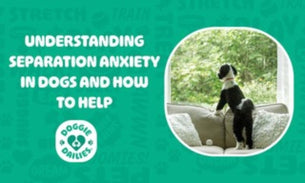Bringing a new dog home is pure joy — wagging tails, sloppy kisses, and a whole lot of love. But sometimes, that joy gets clouded by something many pet parents don’t expect: separation anxiety.
If your pup panics when you leave the house, chews the couch to bits, or howls like they’re auditioning for a wolf pack, you’re not alone. Separation anxiety is one of the most common behavior issues in dogs, and while it’s tough to see your furry friend in distress, it’s absolutely manageable with patience, structure, and a little know-how.
Let’s unpack what’s really going on — and how you can help your dog feel safe even when you’re not around.
What Exactly Is Separation Anxiety
At its core, separation anxiety is fear — fear of being left alone or apart from you. It’s not bad behavior or spite; it’s panic. Some dogs get mildly anxious, pacing or whining when you leave. Others spiral into full-blown distress — barking nonstop, tearing things up, or having accidents indoors.
Understanding this helps shift your mindset. Your dog isn’t being “naughty”; they’re scared. That simple truth changes how you respond.
Spotting the Signs
Common red flags include:
-
Destructive chewing or scratching near doors and windows
-
Excessive barking or howling after you leave
-
Accidents in the house despite being potty trained
-
Trembling, pacing, or blocking the door when you’re getting ready to go
If you’re seeing these, rule out medical issues first. A vet or certified trainer can help confirm whether it’s truly separation anxiety or something else.
Why Dogs Develop It
There’s no single cause. Sometimes it’s rooted in change — a new home, a different routine, a new baby. Rescue dogs, especially those with rough pasts, are more prone to it. And puppies who never learn to be alone can struggle later too.
Whatever the reason, understanding the “why” gives you a roadmap for how to help.
Start With Prevention
If you’ve got a new puppy or a recently adopted dog, teach them early that alone time is safe. Start small — literally minutes — then slowly build up the duration. Give them a treat or special toy right before you step out. This teaches them that good things happen when you leave.
Here’s a simple rhythm to follow:
-
Step out for a minute or two.
-
Come back calmly — no big reunion party.
-
Gradually increase the time apart.
-
Keep the tone light and consistent.
Over time, your dog learns that you always come back — and that being alone isn’t something to fear.
Routine Is Your Best Friend
Dogs love predictability. Keep mealtimes, walks, and downtime on a steady schedule. The more consistent your days feel, the less anxious your dog will be. When life changes (and it always does), ease them into the new routine slowly so they have time to adjust.
Burn Off That Energy
A tired dog is a calm dog. Daily walks, playtime, and mental stimulation make a huge difference. Puzzle feeders, sniffing games, or a quick agility run can help drain nervous energy and keep their mind busy while you’re away.
If Anxiety Has Already Set In
If your dog already struggles, don’t worry — it’s fixable. The most effective combo is desensitization (slow exposure) and counter-conditioning (changing how they feel about it).
Try this:
-
Leave for just a few seconds at first.
-
Pair your departure with a special toy or treat.
-
Keep greetings and goodbyes low-key.
-
Increase the time gradually — only as your dog stays calm.
The goal isn’t to “toughen them up” — it’s to show them that alone time = safe time.
Create a Safe Zone
Many dogs feel better when they have a dedicated space — a crate, cozy corner, or dog bed in a quiet room. Make it inviting with soft blankets, favorite toys, and maybe a worn T-shirt that smells like you. Never use this spot for punishment; it should always feel like comfort, not confinement.
Creating a Safe Space: Separation Anxiety Dog Crate
A dog crate can serve as a safe space for your dog when you're not home. When used correctly, it can provide a sense of security and help manage separation anxiety. To create a positive association with the crate, make it comfortable with bedding and toys. You can also feed your dog their meals in the crate to further reinforce positive associations. It's important to introduce the crate gradually to avoid causing further anxiety. Start by leaving the door open and encouraging your dog to explore the crate at their own pace. The crate should never be used as a punishment. It should always be a positive and safe space for your dog.
When to Call In Backup
If you’ve tried everything and your dog’s still struggling, it’s time to bring in a professional. A certified trainer or veterinary behaviorist can design a personalized plan — and if needed, discuss medications or calming aids to support the process.
That’s not failure; it’s love in action.
Rescue Dogs Need Extra Care
If you’ve adopted a rescue, give them time. They may be carrying old fears and memories you’ll never fully know. Gentle consistency goes a long way — routines, patience, and predictable love can rewrite their story.
The Heart of It All
Helping a dog through separation anxiety isn’t just about stopping the barking or saving your sofa — it’s about building trust. Every calm departure, every quiet return, tells your dog the same thing: you’re safe, and I’ll always come back.
It takes time, but it’s worth it. The bond you build through that process? That’s the real reward.








